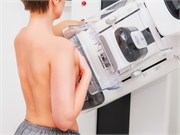AI Beat Humans in Spotting Breast Tumors
By Amy NortonHealthDay Reporter

FRIDAY, Jan. 3, 2020 (HealthDay News) -- Machines can be trained to outperform humans when it comes to catching breast tumors on mammograms, a new study suggests.
Researchers at Google and several universities are working on an artificial intelligence (AI) model aimed at improving the accuracy of mammography screening. In the Jan. 1 issue of Nature, they describe the initial results: Computers, it seems, can beat radiologists both in detecting breast tumors and avoiding false alarms.
Compared with mammography results collected from routine practice, the computer model reduced false positives by 1.2% (at three U.K. hospitals) and 5.7% (at one U.S. center). "False positive" refers to a mammogram that is deemed abnormal, even though no cancer is present.
"That means we could, potentially, create less angst for patients," said researcher Dr. Mozziyar Etemadi, an assistant professor at Northwestern University Feinberg School of Medicine, in Chicago.
Artificial intelligence also bested humans when it came to false negatives -- where a mammogram is interpreted as normal despite the presence of a tumor. The algorithm reduced those cases by 2.7% in the United Kingdom, and by 9.4% in the United States.
Etemadi called the findings "exciting," but also stressed that research into using AI in medicine is "still in its infancy."
Nor will it be replacing humans any time soon. Instead, Etemadi explained, AI is seen as a "tool" to boost doctors' efficiency and accuracy.
As an example, he said AI could be used to "re-order the queue" -- so that instead of analyzing mammograms in the order they come in, radiologists could have certain images with suspicious findings flagged for priority review.
Mammography screening can detect breast cancer in its earliest stages, but it's imperfect: According to the American Cancer Society, it misses about 20% of cancers. And if a woman gets a mammogram every year for 10 years, she has about a 50% chance of receiving a false positive at some point.
The new study, funded by Google, is the latest to explore whether AI can help detect cancer.
Typically, it works like this: Researchers develop an algorithm using "deep learning" -- where a computer system mimics the brain's neural networks. It's exposed to a large number of images -- digital mammograms, for example -- and it teaches itself to recognize key features, such as signs of a tumor.
Other studies have suggested that AI can outperform humans in diagnosing certain cancers. One found that computers bested dermatologists in distinguishing harmless moles from melanoma skin cancer. Another found that AI was typically better than pathologists at finding breast tumor cells in lymph node samples.
This latest AI model was "trained" by exposing it to mammograms from over 90,000 women whose outcomes were known. The researchers then tested the model on a separate dataset, involving mammograms from over 25,000 U.K. women and 3,000-plus U.S. women.
Overall, the model reduced false positive and false negative results. The improvement was greater in the United States. While it's not certain why, Etemadi pointed to one potential reason: In the United Kingdom, it's standard for two radiologists to analyze a mammogram, which generally improves the accuracy.
But while the AI model performed well in this "controlled environment," it remains to be seen how it will work in the real world, said Dr. Stamatia Destounis.
She is a spokesperson for the Radiological Society of North America and a clinical professor of imaging sciences at the University of Rochester, in New York.
"What's needed are clinical studies in real day-to-day practice to see if these findings can be reproduced," Destounis said.
Even in this controlled setting, the AI model was not foolproof. It did not detect all cancers or eliminate false positives. And sometimes it lost out to humans.
In a separate experiment, the researchers pitted the AI model against six U.S. radiologists. Overall, the computer was better, but there were cases where the doctors correctly saw a tumor the machine missed.
So what did the AI model overlook? And what did it see that doctors didn't? No one knows, Etemadi said.
"At this point, we can only observe the patterns," he said. "We don't know the 'why.'"
But, he added, it all suggests the combined forces of human and machine would be better than either alone.
To Destounis, the prospect of a new tool to help spot breast cancer is "exciting."
"I'm hopeful that AI will be another tool in our clinical practice to help radiologists identify breast cancer as early as possible -- when the tumor is smallest and the treatment least invasive," she said.
More information
The American Cancer Society has more on mammography.

The news stories provided in Health News and our Health-E News Newsletter are a service of the nationally syndicated HealthDay® news and information company. Stories refer to national trends and breaking health news, and are not necessarily indicative of or always supported by our facility and providers. This information is provided for informational and educational purposes only, and is not intended to be a substitute for medical advice, diagnosis, or treatment.

